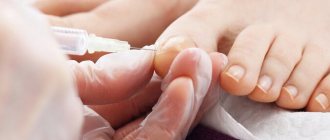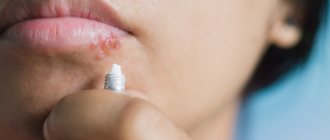Preventive measures
» alt=»»>
Is it possible to prevent the development of a rash in the armpits? Of course you can. To do this, we recommend that you adhere to the following rules: You should not scratch the affected skin, as this can only aggravate your condition. You should not put off visiting a doctor if armpit rashes are accompanied by swelling, general malaise, pain and elevated body temperature.
Before using cosmetics and hygiene products, do not be lazy to familiarize yourself with their composition, and also test them on the back of your hand.
Try to wear clothes that will not restrict your movements and allow your skin to “breathe.” You should also avoid synthetics. It is better to choose cotton underwear. Review your diet and make sure your rashes are not an allergic reaction to foods.
Don't use antiperspirants too often. Choose a good deodorant that won't clog your skin's pores. In early childhood or infancy, such problems may be associated with miliaria. It is characterized by vesicular formations filled with clear liquid and edematous nodules. At the site of the lesion, the healthy pink color of the skin is replaced by pronounced redness.
An important part of preventive measures are regular examinations by a local pediatrician. If alarming symptoms cannot be avoided, you can use baths of decoctions of sage, mint, chamomile, or sprinkle powder on the affected areas
When the origin of the rash is unclear, you should immediately consult a doctor.
To prevent it, the following are recommended: frequent and thorough water procedures, the use of clothing made from natural fabrics, air baths, and avoiding the abuse of warm clothing. Most of these diseases can be easily prevented by regular hygiene procedures and choosing appropriate sizes of clothing made from natural materials.
If you have symptoms:
- It is not recommended to scratch itchy areas;
- to relieve disturbing sensations, use solutions of vinegar or lemon juice;
- You should temporarily avoid cosmetics and hair removal;
- it is necessary to replace clothes with looser, cotton ones.
With proper care of the armpit area, not every virus can cause serious trouble; the body will be protected from most infections. But if infection has occurred, the services of a doctor are no less relevant than in case of infection.
Sensitivity to deodorants and depilatory creams
Sensitivity to deodorants, colored clothing, detergents or depilatory creams due to a number of chemicals they contain can cause redness under the arms, scaly rashes and dandruff, burning and itching. In the worst case scenario, red bumps and blisters may appear, secreting the secretion. Then you need to see a doctor as soon as possible.
A skin reaction to deodorant may occur after the first use, as well as after several months of exposure. If a skin reaction occurs, your doctor may prescribe antihistamines or corticosteroid creams and order an allergy test.
People with atopic dermatitis are more likely to have reactions to deodorants, hair removal creams, and other irritants. To avoid inflammatory conditions, it is recommended to use unscented and alcohol-free deodorants, as well as natural-based deodorants without irritating chemicals.
Avoid using depilatory creams if you feel a burning sensation after application and notice redness after removing the cream.
Rash with itching
Psoriasis is an overgrowth of “extra” skin cells that is accompanied by itching.
Itchy rashes can occur with ringworm, psoriasis, eczema, lymphoma (a type of cancer that affects the lymph nodes), contact dermatitis, deodorant allergies, HIV infection, fungal infections, folliculitis, and others.
To deal with this problem, it is necessary to treat the underlying cause. You can also try various tips and home remedies to help soothe the itching, including applying fruit paste, fresh basil leaves, or peppermint leaves. Apple cider vinegar, aloe vera, clay and oatmeal or flour may also help
Finally, you should avoid the temptation to scratch your armpits, even if there is a burning sensation, you can try cold compresses, cold baths, anti-inflammatory drugs, antihistamines, creams and ointments containing menthol, phenol, camphor, pramoxine, diphenhydramine, benzocaine, etc., and also hydrocortisone.
Diseases
A rash under the arms may indicate the presence of a certain disease caused by fungus, bacteria, mites and other pathogens. In this case, only a specialized specialist can diagnose the problem, based on appropriate laboratory analysis.
The list of the most common skin diseases that provoke the appearance of rashes under the arms includes:
Candidiasis
The fungus of the Candida family is constantly present in the human body. If provoking factors occur, it can begin to actively and uncontrollably multiply, which will lead to a disease such as Candidiasis. As a rule, the main reasons for its appearance are improper hygiene or insufficient care of the skin and mucous membranes.
Candidiasis is characterized not only by rashes in different parts of the body, but also by severe itching, an unpleasant odor, inflammation and swelling of the tissues. Contrary to popular belief, the fungus is localized not only on the genitals, although this is its favorite place. It can breed in all moist and warm areas of the human body, and the armpits are one such place.
You can become infected with Candidiasis not only during sexual intercourse, but also when visiting public places such as a sauna, steam bath or swimming pool. Infection at home is also possible, for example, if you use someone else’s hygiene products or the same towel.
Candidiasis necessarily requires effective and timely treatment
Despite the complexity of therapy, fighting the disease is very important from the point of view of maintaining one’s health, since the fungus in advanced cases can spread to the entire body
Furunculosis
Acute purulent inflammation of the hair follicle, sebaceous gland and adjacent tissues. This disease occurs quite often. At the site of inflammation, a boil appears - an impressive size pimple with a purulent core. It causes a lot of inconvenience, not only moral, but also physical, as it hurts a lot.
It is strictly not recommended to squeeze out a boil at home. There is a risk that the pus will not be completely removed, causing the infection to spread. A complication of furunculosis is blood poisoning. In addition, mechanical damage to tissue can lead to the formation of scar tissue.
Therefore, it is recommended to treat furunculosis under the supervision of a doctor. As a rule, abscesses mature and open on their own, but the doctor, at the request of the patient, can perform an opening operation earlier.
Psoriasis
Chronic skin disease of unknown origin. It is assumed that it is infectious and allergic in nature. Difficulties in determining the type of pathogen cause the fact that today psoriasis is an incurable disease. Modern medicine can only reduce symptoms, thereby easing the patient’s condition.
Nodular and scaly rashes characteristic of psoriasis also appear under the arms. They provoke swelling and redness of the skin, and itching is present. The skin becomes as if tight, making it difficult for the patient to raise his arms. Sweat increases irritation, and therefore such people often have to walk with their arms out to the side.
Eczema
An acute or chronic inflammatory disease of the skin, characterized by pronounced symptoms and a tendency to relapse. The non-contagious disease, however, causes significant discomfort to the patient. Eczema can appear due to exposure to external irritants, such as temperature, chemicals or mechanical influence, as well as diseases of internal organs, in particular the liver, kidneys, gastrointestinal tract, and endocrine system.
Rashes under the armpits, on the arms, legs, body and other parts of the body that are purulent, scaly and blistering in nature are the external manifestations of eczema. Symptoms include severe itching and a feeling of skin tightness.
The true cause of the rash under the arms will be clarified only after visiting a specialized specialist. In this case, self-medication is strictly not recommended, as this can lead to a significant worsening of the situation. In most cases, such a rash does not pose any threat to health, but sometimes it can still indicate the presence of some pathological processes in the human body.
Spots under the arm: types
Before starting therapy, it is necessary to find out what type of spots bothers the patient. This will help identify the underlying cause of the disease, and will also make it easier for the doctor to develop the optimal treatment plan.
If your armpits are red, you should pay attention to the state of your immunity. Often, long-term illnesses or lack of vitamins in the body cause a gradual weakening of protective functions.
Dry spots under the arms
If dry spots appear in the armpit area, a person may experience discomfort and, in rare cases, pain. The skin in this area becomes dry, peels, and the color of the cover changes to red or yellowish. A pink spot also indicates the presence of a specific problem.
Remember that dry skin requires special care: as the disease develops, microcracks or ulcers may appear, which will aggravate the course of the disease.
Weeping spots under the armpits
A wet spot is a consequence of improper hair removal. This area is very delicate, so any mechanical damage can lead to the appearance of ulcers. Usually the cut site hurts, blood oozes from it, and there is a slight itch. It is best to immediately treat the wound with special antiseptic agents.
In addition, such spots can occur due to problems with internal organs or as a result of prolonged stress.
Itchy spots on armpits
If the red spot under the armpit itches, you need to pay attention to external factors. Irritation becomes one of the main manifestations that occurs due to improper shaving process. It is also recommended to avoid using synthetic fabrics (clothing, bedding) and deodorants.
If refusal of irritants is unsuccessful, you need to contact a specialist to identify pathologies.
Folk remedies
The reasons for the appearance of red spots can be different, each of them requires an individual approach when choosing a treatment method. With the appearance of such symptoms, folk remedies that use medicinal plants and products available in every home in their recipes are quite effectively dealt with.
A mixture of poplar and birch buds infused with alcohol is no less effective in reducing the activity of the fungus. The kidneys are crushed in equal quantities and infused in good vodka or alcohol. Before treating the skin, alcohol is diluted with water.
The fungus responds well to treatment with tar; for this purpose, pharmaceutical purified tar and tar soap are used.
Fungal diseases are treated with garlic or radish compresses, however, this remedy should be applied carefully to skin with weeping rashes. It helps well by relieving the symptoms of itching and eliminating inflammatory processes, decoctions of chamomile, lingonberry leaf, St. John's wort - they are brewed and drunk as tea.
Decoctions of chamomile, lingonberry leaf, and St. John's wort herb help well by relieving the symptoms of itching and eliminating inflammatory processes - they are brewed and drunk as tea.
If discomfort in the armpit area is associated with sweating, you can get rid of it with chamomile infusion. Pour 1 spoon of herb with a glass of boiling water. Let stand for 20 minutes, strain. Pour 2 tablespoons of apple cider vinegar into the product. Wash irritated areas 3-4 times a day.
In hot weather, a decoction of oak bark will be a means of controlling sweat. It has an astringent effect and normalizes the functioning of the sweat glands.
You can wash the axillary area with a solution of sea salt (2 tablespoons per 0.5 liters of water). Before use, strain through several layers of gauze.
Prevention
If red spots are found on the body, precautions must be taken. To do this, you will have to change your personal hygiene products to more familiar ones, change into comfortable clothes, and, most importantly, make an appointment with a doctor.
- It is best to avoid soaps with strong fragrances. The most suitable option would be laundry or tar soap. antihistamines.
- An infusion of chamomile is suitable as a traditional medicine. It is necessary to wipe the affected areas of the skin with the prepared solution after any hygiene procedures.
- A weak saline solution (about two teaspoons per 1 liter of water) helps well; you need to wipe the redness with it at least two to three times a day.
Even after the disease subsides, all preventive measures will have to be taken. This is the only way to avoid the recurrence of unpleasant symptoms.
Folk remedies
- birch decoction lotions;
- rubbing with chamomile tincture (a spoonful of dry raw materials is steamed with a glass of boiling water, infused, filtered, a couple of spoons of apple cider vinegar are added);
- rubbing with St. John's wort tincture (two tablespoons of plant material are poured with boiling water and infused);
- rubbing with a decoction of oak bark (pour a tablespoon of oak bark into a glass of boiling water and leave for two hours);
- rubbing with saline solution (two teaspoons of sea salt dissolved in a glass of hot water);
- wiping the affected areas with boiled sunflower oil;
- tobacco compresses (put a handful of tobacco on a bandage, moisten with a strong solution of potassium permanganate) are placed on the armpits at night.
Causes
In order to stop the development of pathology and begin treatment, it is necessary to determine the cause that led to the development of such disorders in the condition of the skin in the armpits. Most often, the problem is a violation of hygiene requirements, as a result of which harmful bacteria actively multiply on the skin of the armpits.
In some cases, underarm irritation is a symptom of a more serious health problem. This could be a decrease in immunity, diabetes, or a sign of endocrine pathologies. In women, such conditions usually occur during periods of hormonal changes, and in men - during active sports.
Hygienic reasons
The most common cause of skin irritation in the armpit area is poor personal hygiene. When sweating occurs, the skin of the armpits, remaining constantly moist, suffers from a lack of oxygen, which affects the condition of the epidermis.
To prevent this from happening, you need to follow a few simple rules:
It is important to avoid wearing clothes and underwear made of synthetic materials, since a lack of oxygen will sooner or later lead to redness of the skin, the appearance of rashes with itching and pain. Avoid the misuse of deodorants and antiperspirants, which can clog the glands that produce sweat. Finding no way out, sweat accumulates under the skin and causes inflammation. Firstly, you do not need to apply deodorant immediately to wet skin after washing. And secondly, many deodorants contain substances that are not entirely beneficial for the skin, which can cause an allergic reaction. Do not use low-quality washing powders for washing clothes and bed linen.
Undissolved grains can remain in the fibers of the fabric, and upon contact with the skin, cause redness with itching and irritation. It is important to be careful when shaving hair in the armpit area, as the razor can leave microtrauma on the skin, which serves as favorable conditions for the existence of bacteria.
Sensitive skin is more prone to irritation and can react to the slightest conditions of discomfort.
Overheating, tight clothing, careless injury to the skin, all these conditions are threatening and can lead to irritation.
After shaving
When planning to shave hair in the armpit area, you must act very carefully and be sure to prepare for this procedure. First of all, it is better to treat the razor that will be used with a disinfectant solution, and the skin should be washed well with hot water and soap.
After shaving, the treated area of skin is wiped with an antiseptic.
However, often even after following all the recommendations, itching and redness occur on the skin. Vaseline, Hydrocortisone ointment or Levomycetin in the form of a solution will help eliminate them. You can try to eliminate irritation with a decoction of chamomile, calendula, sage, and lemon juice.
After deodorant
If skin irritation in the armpits occurs as a result of a reaction to the use of a deodorant, then they no longer use it, but try to purchase some kind of hypoallergenic anti-sweat product. Also, you need to try to reduce the severity of inflammation by using for this purpose a decoction of chamomile, sea salt, as well as zinc ointment, medicinal cream with extracts of aloe, rosemary, sea buckthorn oil, and propolis.
How to treat red spots under the armpit?
Before starting treatment, you must undergo the necessary tests and receive recommendations from a specialist. The use of antibiotics or folk remedies is allowed only after examination by a doctor.
The best remedies for redness in the armpit area are:
- timely hygiene procedures;
- ointment with chamomile extract;
- zinc ointment;
- salicylic acid;
- antifungal agents;
- Sometimes specialists can prescribe antibacterial agents for internal use.
- In case of hormonal imbalance, the doctor prescribes special hormonal medications. The patient must be prepared for the side effects of the chosen drug.
Causes
The etiology of burning and itching of the armpits can be very diverse. The culprits of irritation are divided into two groups:
- Disease-related;
- Not related to diseases.
To get rid of the problem, each of the causes must be eliminated. The skin fold of the armpits is equipped with sweat and sebaceous glands; the secretion of the glands must be removed from the surface of the skin so that this place does not become a habitat for various microorganisms.
Causes not related to disease
In addition to discomfort, irritation of the armpit also brings psychological problems. Due to the fact that open areas of the body are affected, it is necessary to convince others that the redness and wounds are not dangerous and not contagious.
- The use of antiperspirants is not to be confused with deodorants, which only eliminate unpleasant odors. Antiperspirants not only fight odors, but also completely eliminate sweat, as they clog the ducts of the sweat glands. The result is a burning sensation and pain in the armpits. If the skin is very sensitive, severe irritation under the arms can also occur from using regular deodorant;
- Clothes and underwear are too tight, too tight, especially synthetic ones, preventing the skin from breathing;
- Reaction to cosmetics - soaps, creams, gels may not be suitable for the delicate skin of the armpits, causing allergy symptoms;
- Extreme depilation - removal of armpit hair using wax, plucking, electrolysis leads to the formation of red pimples that itch and cause pain;
- Failure to comply with hygiene rules - insufficient use of hygiene measures leads to the formation of pathogenic microflora in the armpit area;
- Increased sweating (hyperhidrosis) - this physiological feature of the body requires enhanced care.
Who gets hyperhidrosis?
- For men with an active lifestyle;
- In athletes;
- During hormonal changes in the body - during pregnancy, adolescence and menopause;
- In people with weak immunity, thyroid diseases, vitamin deficiency;
- In patients with diabetes mellitus;
- In obese people with excess body weight.
In addition to these reasons, people who remove armpit hair using a razor experience irritation after shaving. Small cracks, scratches, redness form, and the axillary lymph nodes may become inflamed.
Causes associated with skin diseases
When, in addition to irritation, inflammation, itching, spots, cracks, and ulcers appear in the armpit area, this indicates the presence of a disease in the body.
- Psoriasis or scaly lichen affects the skin, nails and hair, and can also affect the armpits. Dry psoriatic plaques of red color with a white coating cause peeling, irritation and itching;
- Hidradenitis is a purulent local inflammation of the sweat glands due to a staphylococcal infection, most often occurring on one side, accompanied by itching, mild pain, and general malaise;
- Candidiasis is a fungal infection of the skin of the armpits. It is characterized by cracks, itchy diaper rash, peeling with a whitish coating. The risk of infection increases when visiting public swimming pools, baths and saunas. In case of injuries and scratches that appear during scratching, infection with bacteria is possible;
- Furunculosis is a deep pustular inflammation of the hair follicles and surrounding tissues. Non-hazardous forms of staphylococcus become pathogenic microorganisms in the presence of provoking factors;
- Contact dermatitis is an acute or chronic pathology that develops when the skin comes into direct contact with irritating substances. Redness and swelling of the skin may be accompanied by the presence of blisters, oozing with the formation of crusts. Patients complain of pain, burning, severe itching.
There are other diseases, a symptom of which may be armpit irritation: seborrhea, diabetes, neurodermatitis, cancer, cirrhosis. Long-term use of certain medications, such as antibiotics, hormones, or oral contraceptives, can also cause underarm irritation.
Red spot under the armpit of a child
Particular attention must be paid to the problem that has arisen in the child.
The disease, undetected in time, leads to life-threatening complications.
If a child claims that his armpits are red and itchy, he should contact his local pediatrician to determine the exact causes of the skin rash. During this period, it is not recommended to carry out treatment on your own.
The main problems that arise in children include:
- prickly heat. This phenomenon causes painful, weeping spots that cause discomfort to the child. It is especially common in infants. Parents will help solve the problem: they will have to ensure that the child follows the basic rules of personal hygiene;
- chicken pox. A serious illness accompanied by symptoms such as: increased body temperature, fever, chills, the appearance of inflammation that resembles blisters in appearance, severe itching;
- various infectious diseases that reduce immunity. uncomfortable clothes that rub the delicate skin of the armpits. Listen to the child's words. After the walk, ask if he is comfortable in his new clothes.
Every parent should be wary of red spots on the child’s body, especially if they are accompanied by other, no less serious symptoms that affect the baby’s comfortable existence.
Fungus in the armpit
fungus under the armpits in the photo
In addition to the listed reasons for the appearance of allergies in the armpits, special attention in medicine is paid to such a phenomenon as infection with a fungus such as candida or lichen. Typically, people who suffer from vitamin deficiency, excessive sweating and general disorders of the immune system are susceptible to such an infection.
Also, the effect of urticaria can be observed when the integrity of the skin changes for various reasons.
Candidiasis that appears in the armpit area is distinguished by its special symptoms:
- the formation of zonal diaper rash, which is very itchy and causes pain when scratched;
- peeling in the folds, and it is often accompanied by a white coating, similar in consistency to flour, usually accompanied by a specific odor;
- pain can also be caused by cracks caused by a fungus that violates the integrity of the skin.
In addition, the risk of infection is much higher if there is regular contact of the skin of the body with synthetic fabrics, as well as with any damage to the epidermis. The fungus can easily spread to other areas of the body on the hands when scratched.
In addition to candida, itching in the area under the arms can be caused by such types of fungus as pityriasis versicolor, lichen zhibert and linear. Only a qualified dermatologist can diagnose this or that type of infection; he will also determine the cause of the problem and draw up an adequate plan for getting rid of it.
The duration of treatment for fungus in the armpits varies; the course of therapy can be at least five weeks. Sometimes it takes more than 10 weeks to completely get rid of the disease
It is important to review your diet, which will reduce excessive sweating, which has a detrimental effect on the entire therapy process. In addition, the doctor may prescribe the following medications:
- Mikonorm;
- Tibesil;
- Lamisil;
- Clotrimazole.
In addition to the local application of ointments, dermatologists practice additional therapy from the inside using the following tablets:
- Ketoconazole;
- Fluconazole;
- Itraconazole
It is important to strengthen the body’s immune system during the treatment of fungus in the armpit, since the infection can only be eliminated if one is in complete health
Traditional Treatments
The appearance of a rash in an adult is an alarming sign. There is no point in waiting for its further spread. It is better to get diagnosed and start treatment as early as possible. In some cases, this will protect not only the victim, but also his loved ones.
Treatment for the rash depends on the disease that caused it:
Allergic formations are treated with antihistamines for internal use (Suprastin, Zodak, Zirtek) and special creams and ointments to relieve itching, swelling, and aid in tissue regeneration (Fenistil, Epidel, zinc ointment, etc.). Diseases of a non-allergic nature are treated with traditional medicine (chamomile, mumiyo, salicylic acid, etc.), as well as medications based on zinc, azelaic acid retinoids, etc.
It is very important to maintain diet and fluid balance during therapy. Infectious rashes caused by “childhood” diseases cannot be treated with special means
All symptoms go away on their own after the required time. You can only make this period easier for the patient with the help of nasal medications and antipyretics (for scarlet fever, antibiotics can be prescribed). Scabies, herpes and syphilis require medical treatment, drugs for which are prescribed by a doctor.
» alt=»»>
To eliminate the problem, you first need to investigate the cause of the occurrence. If it is associated with the use of specific cosmetics, they must be eliminated and replaced with better ones that are suitable for sensitive skin. The first step to recovery is to practice daily hygiene.
You need to wash your armpits with products that do not cause allergic reactions and are suitable for a certain skin type. If the skin sweats more during the summer, a saline solution (2 spoons per 1 liter of water) is suitable for washing.
To treat severe irritation under the arms:
- Petrolatum;
- Ointments containing cortisone (Dermatop, Fluvet, Ultralan);
- Preparations based on zinc oxide (Zinc ointment, Desitin, Diaderm, Tsindol).
Very frequent application of oily products to the affected areas with hair can cause clogging of the follicles, and this will further aggravate the situation. In mild cases of fungal skin lesions, the use of local agents is sufficient: Lamisil, Mycoseptin, Lamikon, Clotrimazole.
In more severe forms, oral antifungal antibiotics are required: Amphotericin B; Nystatin; Levorin. For complex forms of dermatitis, combined hormonal ointments are used: Lorinden; Sinalar; Akriderm; Sinaflan; Pimafukort.
In addition to corticosteroids, they may contain antifungal and antibacterial components. If the irritation is caused by fungi or bacteria, it should be treated under the supervision of a dermatologist. Sedatives: Novo-Passit; Phytosed; Sedavit; Valerian tincture. Antihistamines: Zodak; Suprastin; Cetrin; Claritin.
Therefore, local remedies will be ineffective. If a blood test confirms high sugar levels, you must be examined by an endocrinologist so that he can prescribe appropriate treatment. For irritation in the armpits, a low-carbohydrate diet and taking a complex of multivitamins and immunostimulants are recommended.
Redness in the armpits in women
A large percentage of women experience some discomfort in the armpits after depilation or using various cosmetics. This may be due to both allergies and the appearance of cuts after shaving. The best way to solve the problem is to replace the razor with depilatory cream, and also use suitable hygiene products.
It is very important to pay attention to other reasons:
- hormonal disbalance. Serious hormonal changes in the body greatly reduce immunity. Girls should prepare for similar manifestations during puberty, pregnancy and menopause;
- tight underwear. Using such things promotes sweating. On hot days, you should give preference to looser and more comfortable wardrobe items;
- If your armpits itch after eating certain foods, you should talk about allergies or diabetes. It is recommended to take a blood sugar test. kidney and liver diseases;
A comprehensive approach to studying the root cause will help begin treatment as early as possible.
Candidiasis
Candidiasis is a type of mycosis caused by a fungus of the genus Candida. Fungal infection in this case is classified as opportunistic - the pathogen is on the surface of the skin even in a healthy person, but the start of the pathological process is associated with immune disorders, exhaustion of the body, dysbiosis, chronic intoxication, and infectious pathologies.
Candidiasis of large folds occurs in the armpit area. It is also called "yeast diaper rash." This disease is often recorded in children of the first year of life and affects, in addition to the axillary fossae, the inguinal folds. It is observed in people with excess body weight - in the armpit area, in the folds under the mammary glands. The rash looks like small blisters, after opening which dark red erosions appear that tend to merge. A clear boundary between healthy and affected skin is noticeable - a shaft of horny scales with mushy whitish layers forms around the rash. Screenings are also observed - new vesicles surrounding an already formed pathological focus.
https://youtube.com/watch?v=cnIJNlA-bk0
Redness under the arms in men
Often men find themselves in a situation where redness and rashes appear under the arms. This is due to intense sweating, which causes diaper rash. But this factor is far from the only one.
In addition to it, a similar illness can be caused by:
- testosterone levels that deviate from normal. It is worth checking with relatives whether there have been similar cases in the family. Changes in hormones can be inherited from parents;
- prolonged stress;
- seborrhea or psoriasis;
- prolonged exposure to the sun. In some situations, redness caused by diseases can be confused with burns;
- increased sweating due to wearing uncomfortable clothes. A similar thing is observed among workers who are forced to use a uniform throughout the working day.
It should be understood that an adult should carefully monitor the condition of his skin and, if suspicious growths are detected, seek medical help at the hospital.
Causes of rash in the armpits
There are many reasons for the formation of a rash in the armpits. The pathological phenomenon is painful and painful, as in most cases it is accompanied by burning and unbearable itching. Different factors can provoke armpit rashes in adults and children.
Factors causing rash in adults
A rash under the armpit in adults appears under the influence of two types of factors: those caused by non-compliance with hygiene rules and those signaling the development of pathology. The first type includes the following factors.
- Ignoring hygiene rules. People who are obese, have hormonal imbalances in the body, or engage in heavy physical labor are characterized by increased sweating. They must take a bath or shower at least twice a day. If you do not keep your body clean, the moldy skin in the armpits becomes irritated and breaks out in rashes.
- Shaving. Due to careless shaving, the skin of the armpits becomes irritated, covered with small scratches, and begins to itch. You need to shave only with a high-quality razor, and after the caring procedure, lubricate the skin with a softening cream.
- Deodorants and antiperspirants. These skin care medications often clog the sebaceous and sweat glands. As a result, the skin becomes irritated, red, begins to ache and itch intensely.
- Allergy. Armpit rashes are often the result of an allergic reaction to hygiene products. Allergens can be shaving foam, shower gels, and body lotions. Oddly enough, after shaving creams, which, it would seem, should soften and restore the skin, often become irritants.
- Rubbing the skin with clothes. The skin under the arms is thin and delicate, it is easily irritated by tight and uncomfortable clothing. As a result, an itchy rash forms in the armpits.
The second type includes the factors described below.
- Candidiasis. Damage to the skin by yeast-like fungi. The carriers of the infection are people who do not follow hygiene rules. You can catch the fungus in public places: baths, solariums, swimming pools. The infected armpit turns red, becomes covered in a rash, and is very itchy. Candidiasis can quickly spread throughout the body, so it must be treated promptly.
- Eczema. Chronic non-infectious skin pathology of an inflammatory nature, manifested by scaly rashes. Diseased skin is tightened, covered with ulcers, blisters, scaly formations, and itches intensely.
- Psoriasis. Chronic non-infectious dermatosis, accompanied by the appearance of severely itchy and flaky crusts on the body.
- Furunculosis. Inflammation of the hair follicle with the formation of a purulent core. The disease is caused by Staphylococcus aureus, less commonly streptococci. Several boils may appear on the body at the same time.











